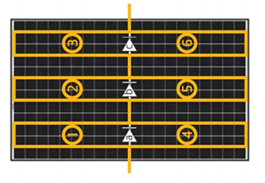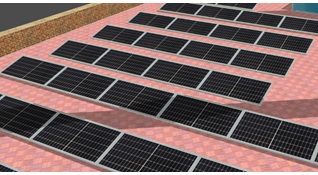It is no secret that self-consumption is in vogue. More and more companies are joining the photovoltaic business and more and more people are interested in benefiting from the advantages of producing their own energy.
In this context, it is very important that the installations are designed in the best possible way, analyzing all the variables involved and, above all, that the investor knows at all times the pros and cons associated with his investment.
We were recently contacted by a client who was very interested in having us evaluate a proposed design for his installation. The available roof had certain limitations, among them, a telecommunications tower of about 20 m high, which had not been given enough importance in the initial visits and designs they had received.
At this point, they asked us the following question: "Is the shadow of this tower really a major limitation?" From Eurocontrol we have responded with a detailed analysis of the installation, to clarify to our client how the technology works and how the punctual shadows affect.
Initial analysis of the proposed installation
We designed the installation on the roof, in an approximate way and taking into account its limitations:
- Telecommunications tower, almost 20 m high, which generates variable shade throughout the year from sunrise to noon.
- Rooftop and other machines involved in the air conditioning of the building that limit the available surface.
What is the effect of shading on this installation?
We start from the assumption that a photovoltaic field is composed of associations of panels in series and these can be grouped in parallel, to enter the inverter (s). A whole string of modules in series, works the same as the panel in which it works in worse conditions, therefore, if a panel stops working, the rest of panels connected in series will do the same.
This same premise can be used to talk about the behavior of a single panel, since each panel is formed by internal rows of solar cells connected in series.
Therefore, if one of these cells is affected by partial shading, instead of generating, (for simplicity's sake), we will say that this cell becomes "a resistor" and will dissipate in the form of heat, the electricity generated by the rest of the cells. To prevent this from happening, each series of x cells within a module is protected with 1 bypass diode, which performs the following task:
|
In the event of partial shading of the module, part of the cells will stop generating voltage and cause a voltage drop that will reverse the polarity in the diode, this opens and allows current to pass through it.
In this way we cancel 1 row of cells and the rest continue to operate under normal conditions. |
|
Until recently, it was common to find modules with 72 cells and 3 bypass diodes, however, recent progress in the manufacture of solar panels made possible that half cell or split cell modules began to be marketed, being an excellent solution for roofs with reduced surface, susceptible to receive shadows throughout the year.
|
|
|
As soon as a cell is completely shaded, the protection diode is biased and 1/6 of the solar panel stops working. If several cells of different series within the same panel are shaded, the panel will stop working. This would occur in this case, by the incidence of the shadow of the tower: |
Source: Eurocontrol's own design in Sketchup software. |
Can we quantify this effect?
Once we understand and know the possible effect of shading, it is important to quantify it and be able to define (always in an approximate way) the losses. Therefore, by importing the design to PVSyst, it is possible to obtain an estimation of the annual losses, making a coherent distribution when connecting the modules in series in order to minimize the percentage of losses.
According to the simulation, it is estimated a loss of 5.5% of the solar resource due to shading and 5.8% of electrical losses due to the connection of the modules, to this, we must add the effects that it supposes, with respect to the degradation of the main equipment.
Our
other news




